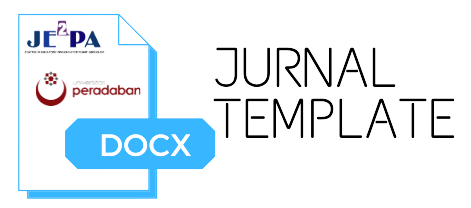WEIGHBRIDGE AUTOMATED SYSTEM USING ESP 8266 MCU NODE
Keywords:
Weighbridge, proof of violation, IoT, Load Cell, TelegramAbstract
Weigh bridges currently have not played an optimal role. This is because there are still many truck transportation service users who fill vehicles that exceed the allowable limit (overload) and often encounter cases of illegal levies made by unscrupulous policy makers and business actors in order to pass vehicles that do not comply with the rules. The purpose of this research is to design and build a weighbridge system prototype for IoT-based truck load logistics vehicles and to create an automatic proof of violation system for truck drivers or other logistics vehicles with excess loads. The research method used is the Research and Development method. The results of this study are to produce a tool in the form of a weighbridge automatic ticket system prototype using the internet of things that can be integrated with the system owned by policy makers from the central to the regions, and also the system can issue proof of violation notifications to drivers directly without any illegal fees. Based on the results of tests carried out on the prototype using the JBI 35gram assumption, if the measured truck load exceeds 35 grams, it will send a proof of violation notification on the telegram and if appropriate, JBI will send a notification to continue the trip to the driver.
References
[2] M. A. A. G and B. H. Susilo, “Nilai Kerusakan Dan Biaya Pemeliharaan Jalan Ruas Cikampek-Pamanukan,†CESD, vol. 01, no. 02, pp. 82–94, 2018.
[3] E. K. I. Afrizal, J. Teknik, S. Dan, U. Bung, and H. Padang, “Analisa pengaruh muatan berlebih terhadap umur rencana perkerasan jalan,†J. Tugas Akhir Jur. Tek. Sipil, vol. 02, no. 02, 2014.
[4] W. Wahyudi, A. T. Mulyono, and W. Santosa, “Pengaruh Muatan Lebih Beban Gandar Kendaraan Berat Angkutan Barang Terhadap Peningkatan Oksida Karbon,†Transportasi, vol. 13, no. 2, pp. 85–92, 2013.
[5] R. Handry, W. Sartono, and H. C. H, “Sistem Informasi Pengawasan Kendaraan Angkutan Barang Pada Jembatan Timbang Untuk Penentuan Pelanggaran Muatan Lebih Dan Damage Factor (Studi Kasus Daerah Istimewa Yogyakarta),†Forum Tek. Sipil No., vol. 2, no. 18, pp. 822–831, 2008.
[6] S. Wibawa, A. Fauzy, and D. A. Habibah, “Efektivitas Pengawasan Pungutan Liar di Jembatan Timbang,†J Ilmu Adm. Negara, vol.12,no.2, pp.74–85, 2013, [Online]. Available: http://download.portalgaruda.org/article.php?article=129520&val=2287.
[7] N. A. Fauzi, G. I. Hapsari, and M. Rosmiati, “Prototipe sistem monitoring berat muatan truk,†e-Proceeding Appl. Sci., vol. 5, no. 3, pp. 2433–2440, 2019.
[8] J. Marpaung and E. Warman, “Perancangan Sistem Pengontrolan Pengukuran Berat Pada Timbangan Kendaraan Secara Automatis,†singuda ensikom, vol. 10, no. 27, pp. 659–669, 2015, doi: 10.4324/9781315621685-74.
[9] G. D. Yurista Nugraha, R. C. Prayogo, A. K. Nugraheni Syafitri, I. N. Berlian, R. J. Azis Pratama, and E. D. Widianto, “Sistem Identifikasi Beban Angkutan Barang yang Terintegrasi pada Jembatan Timbang Menggunakan Kartu RFID,†Techno (Jurnal Fak. Tek. Univ. Muhammadiyah Purwokerto), vol. 18, no. 2, p. 77, 2017, doi: 10.30595/techno.v18i2.1958.
[10] S. Bahri, “Identifikasi jenis dan berat kendaraan melalui jembatan timbang,†J. Inersia, vol. 2, no. 2, pp. 1–5, 2011.
[11] M. S. Wibawa, S. A. Putra, A. Syahrina, and M. Sc, “Pengembangan Purwarupa Sistem Pengawasan Kondisi Kesehatan Jembatan Single Degree Of Freedom Menggunakan Respon Dinamik Prototype Development Of A Single Degree Of Freedom Bridge Health Condition Monitoring System Using Dynamic Responses,†e-Proceeding Eng., vol. 7, no. 1, pp. 2155– 2169, 2020.
[12] Susanti Erma and Triyono Joko, “Prototype Alat IOT ( Internet Of Things ) Untuk Pengendali Dan Pemantau Kendaraan Secara Realtime,†Simp. Nas. RAPI XV, vol. 15, no. May, pp. 401–407, 2017.
[13] M. Tarigan and D. Handayani, “Prototype Pengembangan Sistem Pencatatan Stok Barang Dengan Teknologi RFID,†J. Bit, vol. 16, no. 2, pp. 42–46, 2020.
[14] M. Kusriyanto and A. Saputra, “Rancang Bangun Timbangan Digital Terintegrasi Informasi Bmi Dengan Keluaran Suara Berbasis Arduino Mega 2560,†Teknoin, vol. 22, no. 4, pp. 269–275, 2016, doi: 10.20885/teknoin.vol22.iss4.art4.
[15] D. Yoga Widagdo, Koesmarijanto, and F. Arinie, “SISTEM PENCATATAN HASIL TIMBANGAN MENGGUNAKAN SENSOR LOAD CELL MELALUI DATABASE BERBASIS ARDUINO UNO,†J. JARTEL, vol. 10, no. 1, pp. 13–19, 2020.
[16] F. Putri, “Rancang Bangun Pendeteksi Beban Berlebih pada Tas Ransel Sekolah Berbasis Arduino Uno dengan Sensor Load Cell,†J. Fis. Unand, vol. 9, no. 1, pp. 134–141, 2020.
[17] Hanafi, “Konsep Penelitian R & D Dalam Bidang Pendidikan,†J. Kaji. Keislam., vol. 4, no. 2, pp. 129–150, 2017.
[18] Wahyudi, A. Rahman, and M. Nawawi, “Perbandingan Nilai Ukur Sensor Load Cell pada Alat Penyortir Buah Otomatis terhadap Timbangan Manua,â€J. ELKOMIKA, vol. 5, no. 2, pp. 1–14, 2017.
[19] S. S. Laksono and Nurgiyatna, “Sistem Pengukur Curah Hujan Sebagai Deteksi Dini Kekeringan Pada Pertanian Berbasis Internet of Things,†J. Emit., vol. 20, no. 02, pp. 131–135, 2020.
[20] R. B. Afrianto, “TIMBANGAN DIGITAL OTOMATIS,†J. Tek. Elektro, vol. 1, no. 12, pp. 1–15, 2020.
[21] A. Cokrojoyo, J. Andjarwirawan, and A. Noertjahyana, “Pembuatan Bot Telegram Untuk Mengambil Informasi dan Jadwal Film Menggunakan PHP,†Tek. Inform. Univ. Kristen Petra, vol. 2, no. 14, pp. 3–6, 2013.










